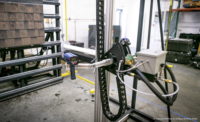IBHS: The Best Hail Resistant Shingles for Storm Season 2022

A hail stone expldoes against a shingle in IBHS' laboratory. Photos courtesy of IBHS.
As the 2022 storm season rolls in, more customers are seeking resilient roofing materials to combat the rise in severe weather events. When it comes to asphalt shingles, contractors can compare products with the Insurance Institute for Business & Home Safety’s (IBHS) roof shingle hail impact ratings.
Refreshed in June 2021, the IBHS’ performance ratings are based on the organization’s hail science research and peer-reviewed hail impact test protocol. IBHS mimics real-life hail strikes by creating hailstones based on studying thousands of measured, weighed, crushed and 3-D scanned hailstones. These are then fired out of CO2-powered guns at shingles to simulate the speed in which they strike a roof.
Dr. Ian Giammanco, lead research meteorologist and senior director for product design at IBHS, said the organization tests Class 3 and 4 impact-resistant products as a way of providing information to consumers.
“The point is to be able to showcase within that group of products there is a range of performance, so the goal is to give the consumer – whether that’s a contractor, roofer or homeowner – the best amount of information for them to make a good decision on what product they want to put on the roof,” he said.
First released in 2019, the updated ratings are transforming the asphalt shingle market for the better. Following the release of the first ratings report, manufacturers pulled two low-performing products and have introduced new ones in their place.
“The products that are now the polymer-modified asphalt shingles in general are becoming the best performers with regards to impact testing,” Giammanco said. “We’ve seen those products in terms of the number of them grow in the marketplace since our two ratings.”
These were the shingles tested in alphabetical order:
- Atlas StormMaster Shake
- CertainTeed NorthGate
- GAF Timberline Armorshield II
- IKO Nordic
- Malarkey Legacy
- Malarkey Vista
- Owens Corning TruDefinition Duration FLEX
- Owens Corning TruDefinition WeatherGuard HP
- TAMKO Building Products Heritage IR

Previously, shingles were rated with a simple pass or fail system. The updated ratings are now broken down into three categories: dents/ridges, tears, and granule loss. These are combined for an overall rating. Each category is given a color-coded rating of “Excellent” (dark green), “Good” (green), “Marginal” (yellow) or “Poor” (red).
“When we started we had a lot more yellows and reds on the chart than we do now, which is really a testament to the asphalt shingle manufacturers wanting to improve their product performance,” Giammanco said.
IBHS obtains the shingles they test from distributors, much in the same way a roofing contractor buys shingles, as well as from large home improvement stores. That way, they are testing the actual products going onto homeowners’ roofs.
Thanks to a partnership between IBHS and the nonprofit Underwriters Laboratories (UL), manufacturers are able to submit their products to UL for testing under IBHS protocols.

IBHS simulates real-world hail conditions using synthetic hail stones
“The manufacturer sector has been very cordial and pleased with the work, and I think it’s an indicator of how quickly they adapted products over the four years this has been in existence to improve performance,” Giammanco said.
IBHS is already revving up to refresh its scorecard for 2023. The organization updates the ratings on a two-year cycle and will test available products this year and in early 2023, with plans to release the updated ratings in June 2023. Giammanco said if new products are made available through standard distribution channels, they will supplement the rankings once they’ve tested the new shingle. Conversely, if a product is pulled from the market, it is removed from the chart.Like roofing contractors, though, IBHS is having to contend with the supply shortage to obtain shingles for 2023 testing.
“We’ve had longer lead times,” Giammanco said. “We just had to realize we have to start the process a little bit earlier – a couple months earlier.”
IBHS is assessing whether it can feasibly apply the hail testing to other roofing products in the future, including metal, tile, concrete clay and stone-coated metal.
Looking for a reprint of this article?
From high-res PDFs to custom plaques, order your copy today!






